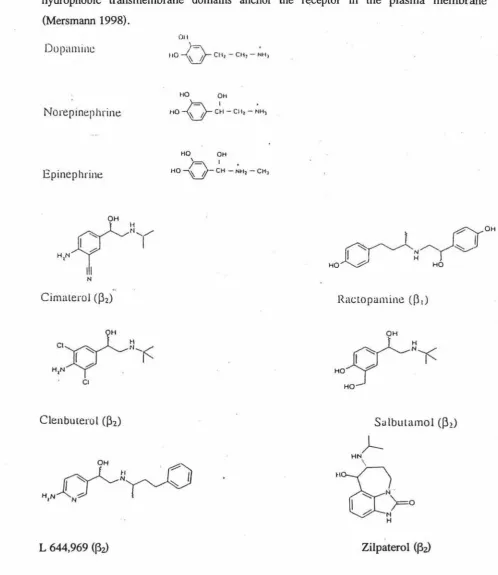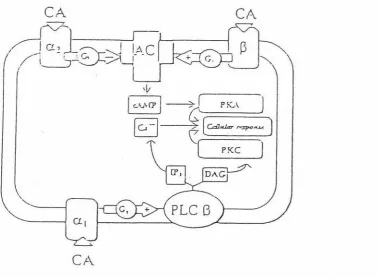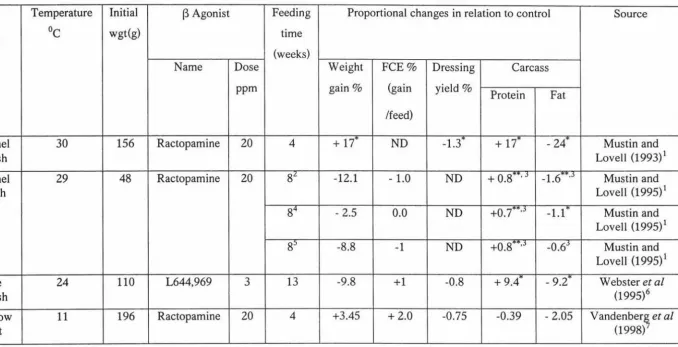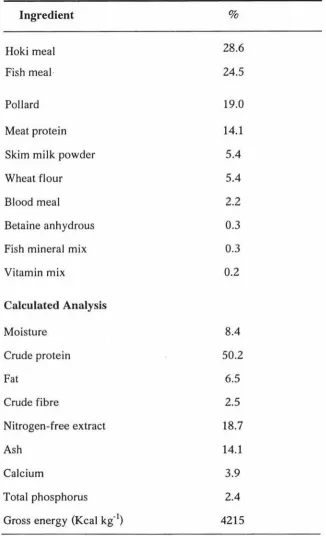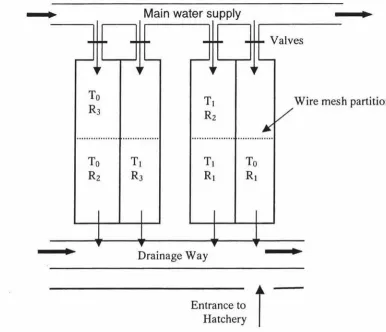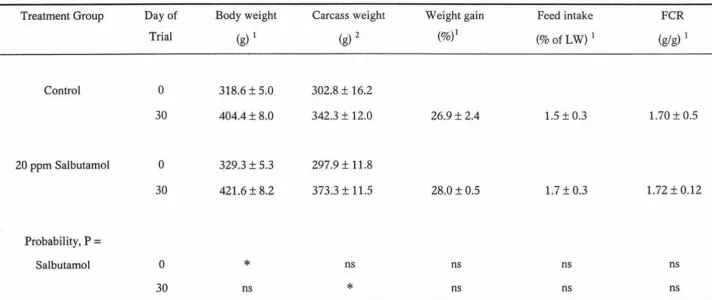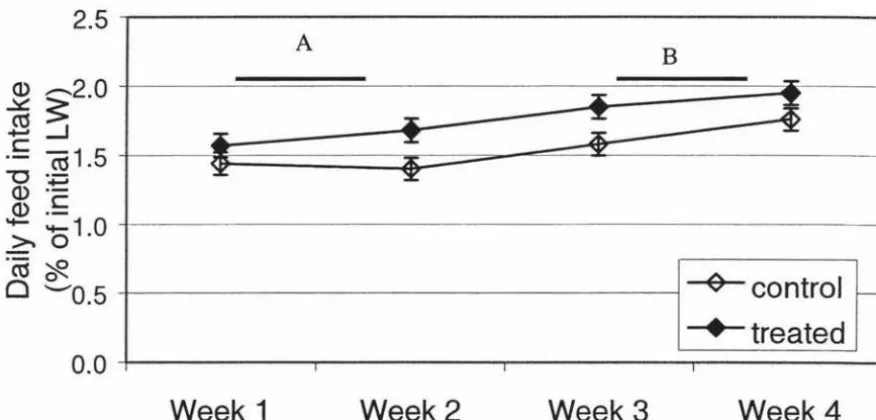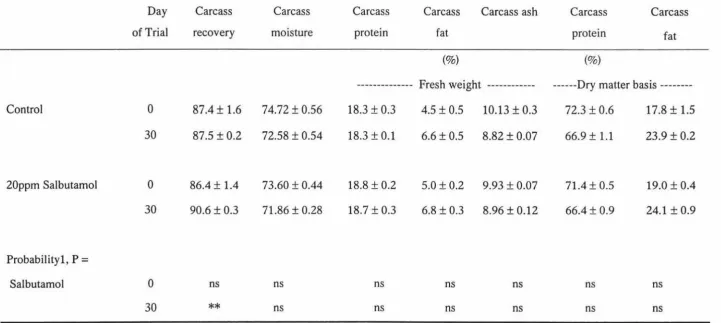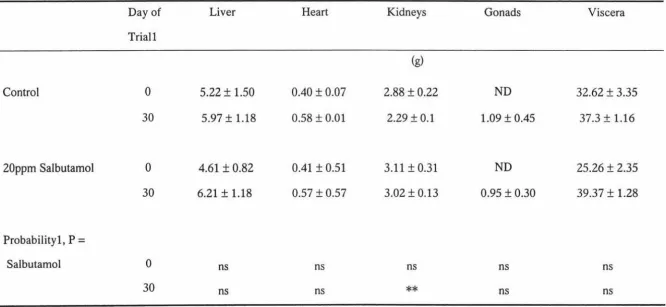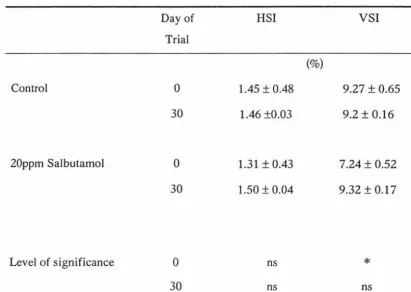EFFECTS OF DIETARY SALBUTAMOL ON GROWTH AND CARCASS COMPOSITION IN RAINBOW TROUT (ONCORHYNCHUS MYKISS)
(WALBAUM)
A thesis presented in partial fulfillment of the requirements for the Degree of Master of Science (Physiology) at Massey University,
Palmerston North, New Zealand.
Abstract
Salbutamol, a
132
adrenergic agonist, has been shown to reduce carcass fat and increasemuscle mass and improve feed conversion efficiency in pigs. In the present study, the
effects of dietary salbutamol at 20 ppm on growth, feed conversion efficiency, carcass
recovery, visceral organ weight, and whole carcass composition of rainbow trout
(Oncorhynchus mykiss) were studied. Rainbow trout (eighteen months old; average
initial weight 324.0±0.4 g) were fed either the control or control + 20 ppm salbutamol
diet for four weeks in a completely randomized design. Fish were weighed at the start
and termination of the study, and records of feed intake were maintained. Carcasses were
analyzed for protein, fat and ash at the start and completion of the four weeks feeding
period. Dietary salbutamol had no adverse effect on fish mortality, health or feed intake.
Dietary salbutamol had no effect (p>0.10) on growth, feed intake or feed conversion
efficiency of rainbow trout. Internal organ weights such as liver, heart, gonads and
viscera-somatic index and hepato-somatic index were also not affected (p>0.10) by
dietary salbutamol. Interestingly, kidney weight was significantly (p<0.01) increased by
salbutamol. However, it is unlikely that salbutamol directly increased the kidney weight.
Increased metabolic load on kidney and blood flow to the kidney could be reasons for
increased kidney weight. Although the final weight and the growth rate were not affected
by salbutamol, the carcass recovery was significantly higher (p<0.01) in salbutamol
treated trout. Whole carcass protein content of both treated and control fish showed no
significant differences and clearly reflected the normal allometric growth and body
composition. It was concluded that dietary salbutamol at 20 ppm level had no repartitioning effect in growing rainbow trout. The effects of salbutamol at various doses
Acknowledgments
My sincere gratitude is expressed to my supervisor Associate Professor Peter Davie for his commitment, critical guidance, wise counsel and encouragement throughout the study.
The support and encouragement of Dr Ted Rohr and Neil Ward is gratefally acknowledged.
My sincere gratitude is also extended to Dr. Ravi Ravindran for his valuable comments on my thesis. I would also express my sincere thanks to Dr Wouter Hendriks for his comments and encouragement throughout the study. Kind support rendered by the Department of Conservation staff at Turangi is also appreciated. Special thanks are also due to Institute of Food, Nutrition, and Human Health for feed preparation and analyses.
I would also express my sincere gratitude to the New Zealand Commonwealth Scholarship Committee, for awarding me a scholarship. Bridge Pharma Inc, Sarasota, Florida, USA is also greatly acknowledged for proposing and financing the project.
The kind helps given by of Singhalese community in Palmerston North is also acknowledged.
Special thanks are due to my mother, brothers and sisters for their love support and encouragement. A very special thank is due to my late father whose greatest satisfaction was his children's academic achievements. Equal gratitude is extended to my mother-in law and father-in-low for their love, unfailing support and encouragement.
Table of Contents
Abstract. ... i
Acknowledgements ... .ii
Table of Contents ... .iii
List of Tables ... v
List of Figures ... vi
1. Introduction ... 1
2 Literature review ... 4
2.1 Manipulation of growth in farm animals ... 4
2.1.1. Somatotropins and related techniques ... 5
2.2.2 Immunological techniques ... 6
2.1.3 Direct genetic manipulation ... 6
2.2. f)- adrenergic agonists: Structure, classification and functions ... 6
2.2.1 Receptor types ... 7
2.2.1.1. Receptor types in fish ... 9
2.3 Signal Transduction pathways of adrenergic agonists ... 10
2.4 Catecholamines and their functions in fish ... 10
2.5 Effects of f)-adrenergic agonists on growth and body composition in terrestrial animals ... 13
2.5.1 Ruminants and swine ... 13
2.5.2 Poultry ... 14
2.6 Effects of
f3
agonists in fish ... 142. 7 Interaction between dietary f)-agonists and experimental conditions ... 17
2.7.1 Nutrition ... 17
2.7.2 Age of the animals ... 18
2.7.3 Treatment time ... 18
2. 7.5 Genetic differences ... 19
2.8 Effect on other organs ... 20
2.9. Muscle redistribution effect of dietary (3-agonists ... 20
2.10 Effects of (3-agonists on muscle fibre types ... 20
2.11.1 Mode of actions of
f3
agonists on skeletal muscles ... 212.11.1.1 Increase blood flow ... 21
2.11.1.2 Hormones ... 22
2.11.1.3 Increased protein synthesis or decreased degradation or both ... 23
2.11.2 Mode of action in adipose tissue ... 24
2.11.2.l Increased energy expenditure ... 25
2.12
f3
agonists and meat quality ... 262.13 The pharmocakinetics, metabolist and tissue residues of
f3
agonists ... 262.14 Limitations of the use of
f3
agonists for meat animals ... 292. Materials and methods ... 28
3. Results ... 35
5. Discussion ... 42
6. Conclusions ... 58
7 References ... 59
List of Tables
Table 1. Effects of ractopamine and L644,969 on the performances and body composition in catfish and rainbow trout. ... 16
Table 2. Percentage composition of the control diet ... 29
Table 3. Influence of salbutamol on body weight gain, feed intake and feed conversion ratio ... 36
Table 4. Influence of salbutamol on the carcass recovery and body composition
parameters of rainbow trout. ... 39
Table 5. Influence of salbutamol on the tissue and organ weight of rainbow trout. .... .40
Table 6. Influence of salbutamol on the hepato-somatic index and viscero-somatic index in rainbow
List of Figures
Figure 1. Chemical structures of endogenous catecholamines and 13-agonists
that can alter carcass composition of farm animals ... 8
Figure 2. Signal transduction pathways of
a
and 13 adrenoreceptors ... 11Figure 3. Experimental tank layout in the hatchery ... 31
1. INTRODUCTION
Fish as food makes a very significant contribution to human nutrition and health.
Although relatively unimportant as a source of energy, fish is a palatable, convenient,
and still moderately priced source of high quality protein, vitamins, minerals,
micro-nutrients and essential fatty acids (EFA). Particularly, the low fat nature of fish and the
presence of EF A eicosapentaenoic acid (EPA, C20: 5n-3) and docosahexonoic acid
(DHA,C22:6n-3) which are essential to human health (Bjerve 1987) make it a highly
desirable food. The essentiality of n-3 unsaturated fatty acids found in fish and
consumers search for diversity and improved nutritional quality of food have led to an
increased demand for seafood.
International trade in fish is increasing, driven by employment and the need to earn
foreign exchange. In 1992, a total of 17 million tons of fish and fish products, valued at US$40.3 billion entered the international market. The share of developing countries has
risen rapidly and currently exceeds 50% of the world catch. Either directly or indirectly
fisheries, support about 200 million people, mostly in developing countries.
Demand for seafood is steadily increasing, but wild fisheries have already reached their
maximum exploitation (FAQ 1993). Aquaculture provides a promising alternative to
this ever rising world demand for fish. During the last two decades aquaculture has
grown rapidly and FAO (1999) predicted that by the year 2000, aquaculture will
account for approximately 25% of world fisheries production. More than 220 aquatic
species are farmed, ranging from giant clams which obtain most of nutrients from
symbiotic algae, mussels which filter plankton, herbivorous carps to carnivorous salmon
(FAQ 1999).
Aquaculture on world-wide basis is now a profitable but competitive animal production
industry (Lovell 1991). High growth rates and low recurrent costs determine the
productivity and the profitability of the operation. In intensive aquaculture systems
Therefore, in aquaculture, high growth rate and efficient feed utilisation by fish is of paramount importance in increasing productivity and profitability.
Efficient feed conversion indirectly helps to reduce the depletion of wild fisheries stocks used in feeds for the aquaculture industry. Production of a kilogram of rainbow trout uses about 2.46 kg of wild fish as fish meal or fish oil (Naylor et al., 2000). In 1997 more than 10,000 metric tones of wild fish were used to feed the most commonly farmed fish. Hunter and Roberts (2000) predicted that 20-25% of the total fish meal production will be used in the aquaculture industry in 2000. Therefore ways of improving feed conversion efficiency are important to reduce the use of fish meal and fish oil for aquaculture feeds.
Aquaculture industries are under increasing pressure to reduce the level of solid and dissolved wastes discharged to the environment (Mayer and McLean, 1995). Increased feed conversion efficiency helps to reduce the waste disposal by reducing level of phosphorous and nitrogenous compounds released to the environment. Increasing environmental concerns by consumers has made it imperative to produce fish sustainably.
During the last 15 years
13
adrenergic agonists have been extensively studied as potential candidates for manipulating growth and carcass composition mainly in terrestrial animals.It is generally accepted that some
13
agonists change the carcass composition by increasing the skeletal muscle protein content while reducing fat content. In some cases, the growthand feed conversion efficiency have also improved. Since these compounds redirect the
nutrients away from adipose tissues towards skeletal muscle hypertrophy, they are
generally termed as repartitioning agents. The major advantage of
13
adrenergic agonists is that, compared to somatotropins,13
adrenergic agonists are orally active and therefore can be given with feeds. A variety of13
adrenergic agonists such as cimaterol, clenbuterol, ractopamine, L644,969 and salbutamol have been studied in various terrestrial farmanimals and laboratory animals. Until recently use of 13 agonists for food animal production
had been banned. Now two
13
agonists, namely ractopamine and zilpaterol, have been cleared for food animal industries in several countries, including the USA.Although
13
agonists have been extensively studied in terrestrial animals, they have been less extensively studied in fish. The first such study was reported in 1992. Two 13 agonists,namely, ractopamine and L644, 969 have been studied in rainbow trout and channel catfish.
Available literature suggests that dietary
13
agonists are not as effective in fish as in terrestrial animals. Of the fish species studied, channel catfish have found to be moresensitive to dietary
13
agonists. Salbutamol is a selective132
agonist and has found to be effective in pigs. The present study investigated the effects of feeding salbutamol at 20ppm on the growth performance, body composition and the organ weight in young rainbow
2. LITERATURE REVIEW
The effects of dietary
f3
agonists on growth and carcass composition as well as their possible modes of actions have been subjected to extensive studies during the last 15 years. Consequently, the general effects of dietary 13 agonists on skeletal muscle proteinaccumulation and adipose tissues of terrestrial animals are well established. Although a significant body of knowledge has been accumulated on the way
f3
agonists affect animal growth and carcass composition, the exact mechanisms of their actions are yet to be understood. The aim of this chapter is to summarise the available information of the effects and possible modes of actions off3
agonists on animals.Fewer than six papers, describe the effects of
f3
agonists on fish growth and carcass composition. Consequently, the following review draws heavily from the studies on terrestrial animals. In the light of differences which exist between those animals and fish, and the great degree of variation of the responses in animals givenf3
agonists, caution must be exercised in extrapolating terrestrial animals findings to fish.2.1. Manipulation of growth in farm animals
Lamming and Peters (1987) reviewed the techniques in farm animal growth manipulation under four broad categories; a) somatotropins and related techniques, b) immunological
techniques, c) the j3-adrenergic agonists and d) direct gene manipulation. Of these
techniques somatotropins and j3 adrenergic agonists act on the animal's metabolism and can be referred to as metabolic modifiers.
2.1.1. Somatotropins and related techniques
It is well established that exogenous somatotropins modify carcass composition of a variety of species by increasing protein and reducing fat content, enhance the feed conversion efficiency, growth and milk yield (NRC 1994). Gill et al. (1985) first reported that recombinant avian and bovine growth hormone increased the growth rate of juvenile pacific salmon. Many studies particularly with young fish have shown that mammalian and piscine recombinant growth hormones were effective in enhancing growth rate in salmon (Reviewed by Down and Donaldson, 1991; Sumpter 1992; Le Bail et al., 1993; Donaldson and Down, 1993; Mayer and McLean, 1995). Somatotropins must be administrated by daily injection or by sustained release implants or by immersion, in the case of fish (Down et al., 1989). Immersion however, is not a very effective means of growth hormone administration (Agellon et al., 1988; Schulte et al., 1989). Most of the studies have been conducted with young pre-smolt or smolting salmon and consequently the effects of these compounds in grow-out fish are not available.
2.1.2. Immunological techniques
The rationale for immunisation against somatostatin is to reduce its inhibiting effects on
growth hormone release. But the results obtained so far have been unconvincing. Spencer
and Williamson (1981) and Spencer et al (1983a,b) observed higher growth hormone, somatomedin levels and rates of growth in lambs immunised against somatostatin but
Varner et al. (1980) did not. Using chinook salmon as a model, Mayer et al. (1994) suggested that it may be possible to block the inhibitory effects of somatostatin on growth
hormone release and thus stimulate the growth by administrating monoclonal antibody
against somatostatin. The positive responses of immunisation against somatostatin were
more pronounced with plesiomorphic breeds compared to with improved breeds (NRC
1994). This could indicate that selection for superior growth automatically selected strains
with low levels of plasma somatostatin. Furthermore, like other immunological techniques
for controlling endocrine regulation, there is a variable response between individuals.
Active immunisation of lambs against GH-RH resulted in increased lean content in carcass
(Keeling and Crighton, 1983). The effects achieved so far are not sufficiently encouraging
for commercial operations.
2.1.3. Direct genetic manipulation
Genetic selection is slow to affect changes in body composition in farm animals and varies
with species. Transgenic salmonids including rainbow trout with increased growth rates
were first reported by Chourrout et al. (1986) and later by several authors (Fletcher et al.,
1988; Guyomard et al., 1989; Du et al., 1992; Devlin et al., 1994). Although the impact of
biotechnology in animal growth manipulation seems to be promising, issues such as
ecological consequences, product safety and above all consumer acceptance of genetically
modified animals have to be taken in to account.
2.2. j3-adrenergic agonists: Structure, classification and functions
Compounds which can be fed with diet, and which reliably and favorably alter carcass
composition are of great interest to the livestock and meat industries including aquaculture.
During the early 1980's interest and active investigation into the influence of synthetic
Asato et al. (1984), Baker et al. (1984), Dalrymple et al. (1984a,b) and Ricks et al. (1984) demonstrated the potential of these compounds in reducing carcass fat while increasing muscle mass in various species.
The terminology used for description of synthetic (3 adrenergic agonists is based on their similarity in structure and function with the naturally occurring catecholamines (CA); dopamine, epinephrine and norepinephrine (Beermann 1993) and octopamine (Fontana et al., 2000). The three endogenous catecholamines are related in structure, function, biosynthesis, metabolism, and their adrenergic control of metabolism, and have been comprehensively reviewed by several authors (Martin 1985; Norman and Litwack, 1987; Timmermann, 1987; Mersmann 1989a; Weiner and Molinoff, 1989; August 1993). Both
catecholamines and (3 adrenergic agonists have properties both of neurotransmitters of the sympathetic nervous system and hormones. Dopamine and norepinephrine, however, act primarily as neurotransmitters in the central and parasympathetic nervous system. The chemical structures of three catecholamines and 13-adrenergic agonists that have proven to be effective in altering the carcass composition in farm animals are shown in Fig. 1.
2.2.1. Receptor types
Response to these endogenous CA and synthetic agonists or antagonists in a specific tissue requires the presence of a receptor, specific for the compound and the functional presence of a signal transduction pathway within the cells. The sometimes differential and sometimes even opposite effects of epinephrine and norepinephrine in tissues led to the concept that different receptors (a. and 13) and associated transduction pathways were
present for each catecholamine. The relative potency or specificity of (3 agonists could be determined by the relative numbers and affinities of these receptors in different organs (Beermann 1993). Studies with fish erythrocytes (Reid et al., 1991, 1993) and hepatocytes (Reid et al., 1992) found that the magnitude of CA stimulated physiological responses are directly related to the number of receptors in the target cells. Based on radioligand labelling, and molecular sequencing techniques the adrenergic agonists are now classified
into; a.1(A, B, C); Az (A, B, C and D); 131; 132 and 133. 13 adrenergic receptors have >400
hydrophobic transmembrane domains anchor the r~ceptor in the plasma membrane (Mersmann 1998).
011
Dopamine
ftO OH
Norepintphrine MO~
/=\
C~t I - Cl 11 - MH1 •HO OH
Epinephrine
/=\
I •HO~-CH - Nfl2 - CH1
P
OHt
HO~~~O
N
..
CimaLerol
CP
2) RactopamineC0d
OH
~~~i<
HO~
HO
L 644,969 ([32) Zilpaterol ([3z)
Figure 1. Chemical structures of the endogenous catecholamines and 13 adrenergic agonists
that can alter carcass composition in fartn animals (Moody et.al., 2000).
[image:16.576.56.555.104.680.2]2.2.1.1. Receptor types in fish
Details regarding non-mammalian adrenergic receptors are scarce. Fabbri et al. (1992)
found that adrenoreceptor subtypes present in fish liver are different from those of
mammals. Studies with eel and bullhead (Zhang et al., 1992), catfish (Fabbri et al., 1994),
channel catfish (Garcia-Sainz et al., 1995) and in rainbow trout (Michelson and Sheridan,
1990) indicated that both a and
f3
receptor types were present in fish liver. However, inrainbow trout Fabbri et al. (1995) could not find an intra-cellular signal transduction
mechanism associated with a receptors although the a and
f3
receptors were present.Fabbri et al. (1992, 1998) found that the
f3
receptor mediated pathway is prominent inrainbow trout liver. Receptor types in the skeletal muscles of the fish have not been studied.
The predominant receptor sub-type in mammalian skeletal muscle is
f3
2 (Liggett et al.,1988). Trout heart was found to be exclusively of the
f3
2 type (Ask et al., 1980, 1981;Gamperl et al., 1994). The presence of red blood cell
f3
adrenergic receptors has beenreported in eel (Bennett and Rankin, 1985) and rainbow trout (Reid et al., 1991). Bennett
and Rankin, (1985) confirmed that they were not type 1 but the exact sub-type is yet to be
established.
Adrenergic receptor types in the adipose tissues of fish have not been studied. Generally, it
is believed that
f3
2 type is predominant in vertebrate adipocyte (Timmermann 1987). Thestimulation of lipolysis by CA is activated through
f3
receptors while through a2 receptorslipolysis is inhibited (Fain and Garcia-Sainz, 1983). Recent studies (Lafontan and Berlan,
1993; Carpene et al., 1994; Fontana et al., 2000) have shown that
f3
3 receptors were alsoinvolved with lipolysis in mammals.
Generalisation of receptor types and their effects in other terrestrial vertebrates to fish
should be done with care. Although the fish heart is primarily a f32 type organ, mammalian
heart is a
f3
1 type organ (Timermann 1987). Many or even most tissues or organs do notcontain a pure population of a or
f3
receptors. Rather a mixture of subtypes is usuallycell types within a tissue. For example f31 receptor concentration in heart may vary from 100% in guinea pig to 65 % in human (Beermann 1993).
2.3. Signal Transduction pathway of adrenergic agonist
All f3-adrenoreceptor sub-types share a common signal transduction pathway whereas a1 and a2-adrenergic receptors do not (Fabbri et al., 1998). A diagram showing the general view of the signal trasduction pathways of CA binding to a or
f3
adrenoreceptors is given in Fig. 2. a1 receptors are coupled to G-protein (Gq) and through phospholipase C, activate the intra cellular second messengers inositol 1,4,5-triphosphate and diacylglycerol. These second messenger systems, in tum increase the intra-cellular Ca++ level and protein kinase C, respectively. az receptors are coupled with G; protein and inhibit the adenosine cyclase. The f3 receptors are coupled to protein Gs and then the a sub-unit of the Gs protein activates the adenyl cyclase second messenger system (Mersmann 1998). Adenyl cyclase in tum stimulates cAMP production. Cyclic AMP subsequently binds to the regulatory sub -unit of a protein kinase and causes dissociation of the ligand-receptor complex and the release of the active enzyme to phosphorylate the target protein. This phosphorylisation results in either activation or inactivation of enzyme.2.4. Catecholamines and their functions in fish
Internal factors such as non-cholinergic neurotransmitters, and/or neuromodulators, and direct blood borne factors including arterial oxygen (Po2), carbon dioxide tensions and external factors (hypoxia, pollutants) are involved in catecholamine release. Plasma CA concentrations in fish are similar to those of mammals (Fabbri et al., 1998). The resting plasma CA level ranges from 1to10 nM, which can be elevated 100 fold under acute stress (Colletti and Olson, 1988; Gilmour et al., 1994).
1992). CA induced hyperglycaemia is associated with simultaneous fall of liver glycogen level and subsequent recovery after 12-24hrs (Ottolenghi et al., 1982). This suggests that CA directly induce hepatic glycogenolysis. Hyperglycaemic conditions induced by CA can be blocked by propranolol, a
13
receptor antagonist, (Wright et al., 1989) but not by the a receptor antagonist phentolamine (Mommsen et al., 1988) indicating the involvement of (3 receptors. However, using radioligand techniques, Fabbri et al. (1992) established the presence of a receptors in rainbow trout liver. As noted earlier, despite the presence of a receptors in the liver, only13
receptor mediated pathway is metabolically active (Fabbri et al., 1992,1998).CA
'
'-._- - - - 1
CA
[image:19.572.118.498.297.574.2]In rainbow trout, insulin inhibits the hepatic gluconeogesis from lactate (Peterson et al.,
1987) and from alanine (Cowey et al., 1977). Although
13
agonists acutely increasedpancreatic insulin synthesis or release (Yang and MacElligott, 1989),
13
agonists chronically reduced the plasma insulin level in pigs (Beermann et al., 1987; Mills et al., 1990). Vandenberg et al. (1998) observed an increase in blood glucose level in rainbow trout fed ractopamine and suggested that chronic catecholamine treatment in fish depressed insulin concentration and promoted hepatic gluconeogenesis.Comish and Moon (1985) found that the production of glucose from lactate accounted for less than 1 % of the total glucose production in American eel. They suggested that amino acids, rather than lactate functions as the main precursor for gluconeogenesis in fish. Vandenberg et al. (1998) observed a positive correlation between the blood glucose level and the weight (protein mass) of fish chronically fed dietary
13
agonist ractopamine. It can be assumed that the major input for gluconeogensis is amino acids in fish, since gluconeogenic capacity increases as the fish grow.Literature on the effects of catecholamines on lipid metabolism in fish is conflicting. In general CA mobilise lipid stores by activating triglycerol lipase through a cAMP-dependent protein kinase, resulting in glycerol and free fatty acid release (Fain and Garcia-Sainz, 1983; Sheridan 1987). Findings of Sheridan (1987) and Sheridan and Muir (1988) that lipolysis was stimulated by noradrenaline in salmon liver support this proposition. In contrast, adrenaline had no effect on non-esterified fatty acid (NEF A) concentration in rainbow trout in-vivo or in-vitro (Murat et al., 1985). Vandenberg and co workers (1992, 1998) found that in rainbow trout, lipolytic response (particularly in liver) to ractopamine was relatively low compared to other animals. Vandenberg et al. (1998) found that chronic administration of the
13
agonist ractopamine reduced the plasma NEF A level in a time related manner. Similar responses have been reported in sheep (Beermann et al., 1987) and in mice (Eisen et al., 1988). Plisetskaya (1980) and Vandenberg et al. (1998) suggested that catecholamine-induced hyperglyceamia influences the effects of catecholamines on lipid metabolism in salmonids by stimulating the re-esterification of NEPA.2.5. Effects of ~-adrenergic agonists on growth and body composition in terrestrial animals
The major effects of (3 agonists are (1) to alter the normal allometric growth by increasing
protein accretion while reducing lipid deposition, (2) to increase the carcass weight relative
to the live weight, (3) to enhance the feed conversion efficiency and (4) in some cases to
increase the growth rate (Reviewed by Hanrahan et al., 1986; Moloney et al., 1992;
Beermann 1989, 1993; NRC 1994; Mersmann 1998; Moody et al., 2000). Ricks et al.
(1984) termed these effective (3 adrenergic agonists as repartitioning agents because of their
ability to redirect nutrients away from adipose tissues toward the muscles.
The (3 adrenergic agonists that have been reported to repartition the dietary nutrients elicit
differing response patterns in laboratory animals (rat) and farm animals including poultry
and fish. Responses are not consistent even within a species. The seven most extensively
used (3 agonists are clenbuterol, cimaterol, ractopamine, L644,969, zilpaterol, salbutamol
and L655,871. All of them are phenethanolamines. Clenbuterol, salbutamol, zilpaterol and
L644,969 are selective (32-agonists while ractopamine is primarily a (31 type agonist (Moody
et al., 2000; see Fig 1).
2.5.1. Ruminants and swine
Generalisation of the effects of (3 agonists is difficult due to differences in agonists and
dosages used, species, their age and physiological stage, treatment period and nutritional
differences of the diets given. Within mammals, ruminants exhibit greater compositional
and growth performance responses to (3 adrenergic agonists than swine, and responses are least in poultry and fish. In many studies with ruminants, (Hanrahan et al., 1987; O'Connor
et al., 1988; Moloney et al., 1990; Anderson et al., 1989) average daily weight gain was
increased by 20%-30%, and feed conversion efficiency was improved 14%-30%. Pigs
show almost half of these responses; daily weight gain of 9% (Anderson et al., 1991) and
feed efficiency of 12% (Bracher-Jacob and Blum, 1990). The 20-40% increase in skeletal
muscle mass commonly observed in growing ruminants was much higher than the 8-22%
muscle mass increment observed in pigs (Adeola et al., 1990). Likewise, the 20-40%
2.5.2. Poultry
Poultry exhibit only modest improvement in growth performance and carcass composition in response to dietary
f3
adrenergic agonist. Generally, daily gain, feed efficiency, and protein accretion increased by 4, 5 and 6 %, respectively, while fat level was reduced by 4-8% (NRC 1994). However, as large as a 10% increment in growth rate has been reported in turkeys by Wellenreiter and Tonkinson (1990).These species differences may be attributed to their genetic potential to grow (Mersmann 1998). Species such as poultry have been extensively selected for growth and thus may have a growth rate close to the biological maximum with little room for response. Other species such as sheep have not been so intensively selected for growth and therefore have more potential to grow in response to dietary
f3
agonists. Differences in agonist receptor selectivity, density and their signal transduction pathways in different species may also be responsible for the differential responses.[32 adrenergic agonists have found to be more effective in sheep and cattle but less effective
in swine. Ractopamine, a [31 type of agonist is less effective in ruminants, particularly in
sheep but more effective in swine (Moody et al., 2000). Compared to clenbuterol, cimaterol and ractopamine, salbutamol has been tested less extensively as a repartitioning agent. All the studies reported in the literature have used pigs. When effects of salbutamol in pigs, as reported by Cole et al. (1987), are compared with the effects of ractopamine as reported by Anderson et al. (1991), it can be inferred that ractopamine is more effective in relation to growth, feed efficiency and protein accretion while salbutamol is more effective in reducing carcass fat than ractoparnine. However, it must be noted that the methodological differences between these two experiments render this comparison superficial.
2.6. Effects of (3 agonists in fish
While there are numerous reports on the effects of
f3
agonists on terrestrial livestock, thereare only a few which deal with fish (Table 1). Mustin and Lovell (1993) conducted the first
such study with fish and reported that channel catfish (/ctalurus punctatus) fed with a diet containing 20 ppm ractopamine gained 17% more weight, 24% more muscle protein and
18% less mesenteric fat than those fed control diet. Muscle water content increased with
decreased fat content. Dressing percentage was significantly reduced in the treated fish.
They argued that decreased muscle fat content might be the reason. In their study Mustin
and Lovell (1993) fed the channel catfish with a diet containing 36% crude protein, a higher
level than usually used in commercial catfish production. Webster et al., (1995) found no
significant difference in weight gain in channel catfish fed with dietary L644, 969 in a low
protein diet (27%). In a later study, Mustin and Lovell, (1995) fed channel catfish to
satiation with diet containing three levels of dietary protein (240 g kg-1, 300g kg-1 or 360g
kg-1) with 0 or 20 ppm ractopamine and at a restricted diets containing 240 g kg-1 or 360 g
kg-1 dietary protein with 0 or 20 ppm ractopamine. They found that weight gain response
to ractopamine was dependent on the dietary protein concentration and ration size.
However, compaed to growth parameters, body compositional parameters were found to be
less dependent upon protein concentration of the diet and the ration size.
Webster et al. (1995) studied the effects of L644,969 on the body composition and growth
in blue catfish fed with two dietary protein levels. They did not find a significant effect of
this [32 agonist on growth parameters at either of the protein levels. However, treated catfish had higher fillet dressing percentage and lower abdominal fat than control fish.
Furthermore, feeding L644,969 increased the fillet protein 15% and reduced the fat 28%.
Recently, Vandenberg and Moccia (1998) studied the effect of four levels (5, 10, 20 and 40
ppm) of the [31 agonist ractopamine on rainbow trout. They reported higher thermal growth
co-efficient (=Final weight0.333-initial weight0.333/ mean daily temperature* time; see Cho
1992) in fish fed 10 ppm ractopamine between weeks 1 and 4. During the first four weeks
of feeding, at 10 ppm daily feed intake was significantly reduced while during the same
Table 1 . Effect of ractopamine and L644,969 on the performances and body composition in different fish species.
Temperature Initial
13
Agonist Feeding Proportional changes in relation to control SourceSpecies OC wgt(g) time
(weeks)
Name Dose Weight FCE% Dressing Carcass
ppm gain% (gain yield%
Protein Fat
/feed)
Channel 30 156 Ractopamine 20 4 + 17'" ND -1.3"' + 17" - 24"' Mustin and
Catfish Lovell (1993) 1
Channel 29 48 Ractopamine 20 8£ -12.1 - 1.0 ND + 0.8'""',j -1.6""",j Mustin and
catfish Lovell (1995)1
84 - 2.5 0.0 ND +o.7""".J -1.1"' Mustin and Lovell (1995)1
8' -8.8 -1 ND +0.8"'"',j -0.6j Mustin and Lovell (1995) 1
Blue 24 110 L644,969 3 13 -9.8 +1 -0.8 + 9.4"' - 9.2"' Webster et al
Catfish (1995)6
Rainbow 11 196 Ractopamine 20 4 +3.45 + 2.0 -0.75 -0.39 -2.05 Vandenber~ et al
trout (1998)
1 36% protein. 2 24% protein. 3
Muscle and fat content. 4 24% protein, restricted diet. 5 36% protein, restricted diet. 6 36% protein, satiation feeding.
7
The feed conversion efficiency was also higher during first four weeks in fish fed with 10 ppm ractopamine. When 10 ppm ractopamine was fed, carcass protein content was significantly
increased with reduced carcass fat content during the 4-8 week period. At 5 ppm ractopamine whole carcass protein content was higher after the first four weeks. However, the carcass fat content was not significantly reduced. Neither of these effects were seen after the 8th week.
Although the growth rate data do not agree with the observations of Mustin and Lovell (1993 and 1995), later studies by Webster et al. (1995), Vandenberg and Moccia, (1998) found an
increased carcass protein content and decreased carcass fat content in fish fed j3 agonists
compared to control fish, indicating that
13
agonists have repartitioning effects in fish,particularly in catfish. Furthermore, as in the case of other terrestrial animals, the
13
agonist used, the dose, dietary nutrients, length of the treatment, physiological stage of the fish seem to be thedeterminants of the effects of
13
agonists in fish2. 7 Interaction between dietary (3 agonists and experimental conditions
2.7.1. Nutrition
The repartitioning effect of dietary
13
agonists have been reported in both adequate and restrictedfeeding conditions in lambs (Kim et al., 1989) and pigs (Bracher-Jacob and Blum, 1990; Bracher-Jacob et al., 1990; Dunshea et al., 1993; Mitchel et al., 1990; Oksbjerg et al., 1994). However, significant increases in growth rate have occurred only in well-fed animals. MacRae et al. (1988) observed increased protein deposition and reduced fat deposition in lambs given clenbuterol fed at 1.3 or 2 times maintenance energy supply. Mustin and Lovell (1995) found that in channel catfish, the growth promoting effect of ractopamine was greatly diminished when dietary protein level was reduced.
Generally animals fed 13 agonists require increased dietary protein to accommodate the increased muscle deposition rate. Increased maintenance energy and reduced energetic efficiency increase the energy requirement (Reeds and Mersmann, 1991). Furthermore, although the growth is
enhanced by 13 agonists, in many cases, daily feed intake does not change or in some cases reduces, at least initially. Therefore, in order to achieve the full potential of the beneficial effects
2.7.2. Age of the animal
The magnitude of the effects of dietary
f3
agonists is related to the animal's potential to depositfat and skeletal muscles. Thus, the effects are more prominent in heavier fattening animals
compared to pre-weaning and young rapidly growing animals. In contrast to consistent effects in
heavier finishing animals, the effects of
f3
agonists on carcass composition and growth of youngpigs (Mersmann et al.,1987), calves (Williams et al., 1987b) and in lambs (Williams et al., 1989)
were not significant. However, Oksbjerg et al. (1994) found that salbutamol could increase the
muscle growth in growing pigs if the level of dietary protein was raised by 10 % above the
recommended level.
The lack of response in young animals may be due to the low receptor numbers in these animals,
lower affinity, or more rapid desensitisation of receptors to
f3
agonists.2.7.3. Treatment time
In general, the magnitude of differences is greatest within first 1-3 weeks of treatment and declines with continued administration (Beermann et al., 1986; Wallace et al., 1987; Kim et al.,
1989; Moloney et al., 1990). The treatment time required to plateau the daily gain is higher for
cattle compared to sheep and swine. In cattle given
f3
agonists, the daily gain plateaued after10-16 weeks (Fiems et al., 1990), 5 weeks (Sillence et al., 1993), and 8 weeks (Barash et al., 1994)
after treatment. In swine, ractopamine stimulated daily gain plateaued after 3 weeks of
treatment, but carcass composition changes continued as ractopamine treatment duration
increased (Anderson et al., 1987). It is not surprising that time required for the growth responses to plateau reflects the general species differences in growth. Chronic administration
causes down regulation of receptors leading to an attenuation of the responses. Kim and Sainz
(1990) measured the 13 adrenergic agonists receptors in rat skeletal muscle at various times
during cimaterol treatment and found that reduction in receptor density correlated with the
attenuation of muscle weight gain. Reduced response can be restored by withdrawing the drug
or by increasing the dose (Kim et al., 1995).
2. 7.4. Sex differences
Sex differences among species that respond to the dietary
f3
agonists are minimal or non-existentin ruminants (Hanrahan et al., 1987; NRC 1994) but have been reported in poultry (Dalrymple et
with cimaterol reduced the carcass fat of the order of 10% in female birds but only
approximately 5% in male birds (Dalrymple and Ingle, 1987). This sexual dimorphic effect may
be due to the tendency of female birds to deposit more fat than male birds (NRC 1994). Uttaro
et al. (1993) found that ractopamine reduced the carcass cholesterol content in barrows, but not
in gilts.
2.7.5. Genetic differences
Reports on the effects of genetic make up on the responses in animals given dietary
f3
agonistsare conflicting. Although animals having a greater potential to accrete lean might be expected
to have a greater response to dietary
f3
agonists, this is not always the case. When cimaterol wasfed to obese and lean pigs (Yen et al., 1990a), ractopamine to genetically obese or lean pigs (Yen
et al 1990b) or to pure or cross bred pigs (Yen et al., 1991) no differential responses were
detected. Hanrahan et al. (1987) observed no breed differences in lambs in response to
cimaterol. Eisen et al. (1988) fed cimaterol to two mice lines (genetically selected for higher
growth and unselected control group) and found a similar response in growth and fat reduction in
both lines. In contrast, several studies have shown that significant breed differences in dietary
f3
agonists induced responses. Gu et al. (1991a,b) observed a greater muscle mass response in
ractopamine fed pigs of leaner genotype. Bark et al. (1992) found that ractopamine increased the
muscle accretion and reduced the fat deposition to a greater degree in pigs with a high genetic
capacity for lean tissue growth than those with a low capacity. Salbutamol increased the carcass
protein and reduced the fat in both traditional and meat type pigs. The reduction in fatness was
however less pronounced in the leaner meat genotype (Warris et al., 1990a).
The rate of muscle protein synthesis is directly associated with muscle DNA concentration. In
pigs, muscle DNA concentration is greater in breeds with high genetic capacity to deposit more
lean (Lundstrom et al.,1983; Hausman and Campion, 1986). The different responses may be due
to differences in number and/or density of
f3
receptors in the tissues. In support of this argument,Bocklen et al. (1986) found that an extremely muscular breed of pig (Pietrain) had higher
densities of
f3
adrenergic receptors in skeletal muscles and adipose tissues than in the sametissues of pigs of a less muscular breed (Large White).
Hence, it can be inferred that
f3
adrenergic agonists are effective in a wide range of genotypes,tissue accretion are used. One possible reason for this is that genetic selection for higher lean growth simultaneously may result in establishing genotypes with higher receptor density or
efficient underlying metabolic pathways involving
f3
agonist actions.2.8. Effects on other organs
f3
agonists target skeletal muscle for protein deposition (Reeds et al., 1986; Williams et al.,1987b; Forsberg and Wehr, 1990; Moloney et al., 1990). The weight of most visceral organs,
including liver, kidneys, gastrointestinal tract, skin, and bone is not altered or may be decreased. Decreased liver weight has been reported in dietary
f3
agonists given to pigs (Moser et al., 1986;Mersmann eta/., 1987), rats (Emery eta/., 1984) and chickens (Hamano eta/., 1999). Reduced kidney weight has been reported in pigs (Moser et al., 1986) and in rats (Emery et al., 1984).
Bracher-Jacob and Blum (1990) has reported decreased heart weight in pigs treated with
repartitioning agent R0-16-8714. In contrast, increased protein deposition in heart has been reported in rats (Reeds et al., 1986) and in calves (Williams et al., 1987b).
2.9. Muscle redistribution effect of dietary
f3
agonistsSeveral studies have shown that
f3
agonists have a muscle redistribution effect in terrestrialanimals. Dose dependent increases in proportion of muscle mass associated with the hind
quarters and decrease in proportion associated with fore quarters have been observed in steers
(Moloney et al., 1990; Wheeler and Koohmaraie, 1992) sheep (Beermann et al., 1986; Cleays et al., 1989; Higgins et al., 1988) and in pigs (Moser et al., 1986; Warris et al., 1990a) given
various
f3
agonists. In broiler chicken, cimaterol increased the weight of the leg muscle (Morganet al., 1989; Gwartney et al., 1991). Bark et al. (1992) suggested that differential responses in
different body areas may reflect the different number and/or density of the receptors.
2.10. Effects of (3 agonists on muscle fibre types
Dietary
f3
agonists cause muscle hypertrophy rather than hyperplasia (Martin 1985; Beermann etal., 1987; Kim et al., 1987). Several authors (Humby et al., 1986; Kim et al., 1987; Beermann et
responses of type II muscle fibres were greater than type I muscle fibres. Dietary salbutamol in
pigs (Oksbjerg et al., 1994) and cimaterol in bulls (Vestergaard et al., 1990) decreased the proportion of fast type a (Ffa) while increasing fast type b (Ffb).
Protein turnover varies in different skeletal muscles due to the differences in fibre type
composition. Proteolytic capacity varies in different muscle types and in the same muscle from
different species (Quali and Talmant, 1990; Koohmaraie et al., 1991b). For example, pig red muscles have low calpastatin activity compared to white muscles and the activity in the
longissimus muscle is lower than that found in the same muscles of cattle and sheep
(Koohmaraie et al., 1991b).
Differences in relative muscle fibre types, their metabolism, proteolytic activity in different
species and even between the different muscles within a species and their interactions may play a
role in the relative efficiency of agonists in different species, and muscle area distribution within
a species
2.11.1. Mode of action of
f3
adrenergic agonists on skeletal musclesHow 13 adrenergic agonists affect skeletal muscle metabolism is unclear. Clenbuterol induced
muscle hypertrophy was blocked by propranolol, a non-selective 131 and 132 antagonist
(MacLennan and Edwards, 1989) or by 132 specific antagonist ICI-118-551, (Choo et al., 1992). Though these findings confirm the involvement of 13 adrenergic receptor mediated pathway of
action, the primary site of action is controversial. Evidence has been reported for both direct
increased skeletal muscle protein synthesis and reduced protein degradation. Other indirect
mechanisms include altered plasma hormones and metabolites and increased blood flow.
2.11.1.1. Increased blood flow
13 agonists stimulate blood flow to muscle of the hind limbs of cattle (Eismann et al., 1988; Eismann and Huntington, 1993), sheep (Beermann et al., 1987; Aurousseau et al., 1993) and pigs (Mersmann 1989a, b). An increase in blood flow to the skeletal muscle may enhance the
process of hypertrophy by delivery of increased amounts of substrate and energy sources for
protein synthesis. Likewise, increased blood flow to adipose tissue may be important to carry
the NEPA away from the adipose tissue to facilitate the efficient lipolysis (Mersmann 1998).
surgically catheretized to infuse cimaterol or saline and could not find significant increase in
blood flow to the cimaterol infused hind-limb.
2.11.1.2. Hormones
Metabolic hormones such as insulin, growth hormone, and the thyroxine play a key role in the
regulation of protein, lipid and carbohydrates metabolism. Therefore,
f3
agonists may exert theireffects via these hormones.
Growth hormone
In general the reported literature on the effects of
f3
adrenergic agonists on plasma hormoneprofile of treated animals are inconsistent across the studies. In-vivo studies with sheep fed
dietary L 644,969 (Zhang et al., 1995) or cimaterol (Beermann et a/.,1987) have shown that
dietary
f3
agonists increased the plasma growth hormone (GH) levels. On the other handsalbutamol (Hansen et al., 1997), ractopamine (Dunshea and King, 1994) and clenbuterol
(Miller et al., 1988) did not change the GH level and plasma insulin like growth factors-I
(IGF-1) (Dunshea and King, 1994).
Additive effects of a combination of growth hormones with clenbuterol in cattle (Maltin et al.,
1990), salbutamol in pigs (Hansen eta/., 1997) and ractopamine in pigs (Jones eta!., 1989) have
been reported. This implies that growth hormones and
f3
agonists act through two distinctpathways. The receptor structure and intra-cellular pathways of GH and
f3
adrenergic agonistsare quite different. GH has generalised hypertrophic effect on almost all the organs while the
effect of
f3
agonists is mainly confined to skeletal muscles. GH has a profound effect on feedintake whereas the effect of
f3
agonists on feed intake is minimal. (Mersmann 1998). Theabsence of consistent effects on GH level and the above mentioned differences between GH and
f3
agonists provide strong evidence against the possible role of GH in the mode of action off3
agonists.
Insulin
Although cimaterol induced an acute increase in insulin in sheep (Beermann et al., 1986;
O'Connor et al., 1988) and cattle (NRC 1994), chronically decreased insulin levels have been
reported in dietary
f3
agonist treated pigs (Mills et al., 1990) and sheep (Beermann et al., 1987).Furthermore, clenbuterol has increased the muscle weight in control and diabetic induced rats as
Increased insulin sensitivity or responsiveness in the skeletal muscles of dietary
f3
agonists treated cattle (Eismann et al., 1988) and rats (Budohoski et al., 1987) has been reported. Meanwhile, adipocytes of dietaryf3
agonist fed rats (Hausman et al., 1989) and pigs (Liu and Mills, 1990) showed a decreased sensitivity to insulin. Anderson et al. (1991) suggested that the repartitioning effect off3
agonists are due in part to the opposing effect off3
agonists on insulin sensitivity in skeletal muscle and adipose tissues. In contrast, an in-vitro study by Orcutt et al. (1989) and in-vivo studies by Dubrovin et al., (1990) and Eismann and Bristol, (1998) did not find significant differences in insulin sensitivity of the adipocytes betweenf3
agonist fed or control animals. In conclusion, it is unlikely that insulin directly or indirectly plays a significantrole in the mechanism of
f3
agonist action.f3
agonists induced skeletal muscle growth has been observed in diabetic (Eisemann and Bristol, 1998), hypophysectomized (Thiel et al., 1987), castrated and adrenalectomized (Rothwell and Stock, 1988), denervated (Zeman et al., 1987), genetically somatotropin deficient (Bates and Pell, 1991) and hyper and hypothyroid (Forsberg and Wehr, 1990) animal models. Recent work by Byrem et al. (1998) confirmed that the effect off3
agonists on skeletal muscle is direct and any indirect effect via hormones and increased blood flow is insignificant. No chronic increase in blood flow, or changes in endocrine status was found in cimaterol infused hindlimb of sheeps. However, the net protein synthesis was increased in the cimaterol infused hind-limb confirming that the effect of cimaterol on skeletal muscle was not mediated through increased blood flow or changed endocrine status.2.11.1.3. Increased protein synthesis or decrease degradation or both?
Increase in muscle protein deposition can be brought about either by increased protein deposition or by decreased degradation or by both. Evidence for all three possibilities is available in the literature.
(Eismann et al., 1988) have been reported in clenbuterol fed calves. Similarly, Wilson et al. (1988) and Morgan et al. (1989) found that cimaterol was effective in reducing protein degradation rate. Reduced activity of the proteolytic enzyme calpain or increased anti-proteolytic calpastatin has been observed in several species treated with
f3
adrenergic agonists (Higgins et al., 1988; Wang and Beermann, 1988; Koohmarie et al., 1991a,b) and supports the argument that reduced protein degradation plays major role.Anderson et al. (1991) proposed a diphasic mechanism of action of j3 agonists in skeletal muscle; initial reduction in overall muscle protein degradation is followed by increased protein synthesis. In support of this hypothesis, Wheeler and Koohmarie (1992) found that the reduced protein degradation effect of L644,969 started in the first week of treatment and was maintained until the third week and by the sixth week the degradation rates were similar between treated and control groups. Similar effects of
f3
agonists on skeletal muscle protein metabolism has been reported by Reeds et al. (1986), Eismann et al. (1988), Eadara et al. (1989), Yang and McElligott, (1989) and Koohmarie et al (1991a). Collectively these findings support the diphasic mechanism proposed by Anderson et al. (1991) of an initial reduction in protein degradation followed by an increased rate of protein synthesis.Interestingly, all the
f3
adrenergic agonists that have been shown to be effective throughincreased protein synthesis and/or reduced degradation are
f3
2 type agonist. In all but oneexample (Dunshea and King, 1994), ractopamine, a [31 agonist has shown to be effective
through increased protein synthesis. In vitro studies with pigs (Helferich et al., 1990) also confirmed that ractopamine acts primarily through increasing protein synthesis. Collectively,
these findings support the hypothesis that [32 agonists act by increasing protein synthesis rate
and/or decreasing protein degradation rate while [31 agonists increase the protein synthesis rate.
2.11.2. Mode of action in adipose tissue
Reduced lipid level can be achieved either by reducing lipogenesis or by increasing lipolysis. It is generally accepted that
f3
agonists cause activation of hormone sensitive lipase and inactivation of lipogenic enzymes involved in de-nova synthesis of tryglycerides (Fain and Garcia-Sainze, 1983). Acutely increased plasma NEFA levels have been reported in pigs (Mersmann et al., 1987; Adeola et al., 1992), in cattle (Blum and Flueckiger, 1988) and in fishin-vitro studies have not yielded consistent results (Duquette and Muir, 1985; Rule et al., 1987;
Miller et al., 1988; Mills and Liu, 1990; Peterla and Scanse, 1990). Different experimental
conditions, particularly incubation conditions, may be the reason for inconsistent in-vitro results.
Liu et al., (1989) found that
13
agonists reduced the lipogenesis and increased lipolysis in pigs.However, lipolytic responses were more pronounced than the anti-lipogenic responses.
Determination of lipogenesis is not straightforward and involves the measurements of lipogenic
enzyme activities. Nevertheless, in-vitro studies with chicken tissues (Rosenberg and Steel,
1995) and pigs adipose tissue (William et al.,1987a) have shown that
13
agonists depresslipogenesis as well.
2.11.2.1. Increased energy expenditure
Reeds and Mersmann (1991) presented evidence to suggest that decreased rate of fat deposition
was at least partly due to the diversion of amino acid carbon chains from energy producing
metabolic pathways and partly due to increased rate of energy expenditure in
13
agonist treatedanimals. Increased skeletal muscle protein synthesis uses a large proportion of available amino
acids and thus makes them unavailable for energy production. Consequently more and more fats
are utilised for energy production. Reviewing the literature, Reeds and Mersmann (1991)
concluded that up to 60% of the reduction of fat deposition could be attributed to the
non-availability of amino acid carbon as an energy source and the use of fat in place of them. The
remaining reduced fat deposition is largely associated with increased energy expenditure. In
support of this argument, increased energy expenditure in
13
agonists treated calves (Williams etal., 1987b), sheep (MacRae et al., 1988) and rats (Rothwell and Stock, 1988; Emery et al. 1984)
has been reported. Energy expenditure increased due to several reasons. Kim et al. (1989)
found that cimaterol increased the fasting heat production and metabolisable energy requirement
for maintenance in sheep. Since energy cost of protein deposition is higher than that of fat (20
kj/g vs 13 kj/g) increased protein deposition demands more energy. Reeds et al. (1982)
estimated that synthesis of protein contributed a minimum of 17% daily energy expenditure. The
energetic efficiency of fat storage is reduced by producing a condition in which considerably
more fatty acids are synthesised de-nova than are deposited. Therefore, increased energy
requirement arises from maintenance, protein deposition as well as for lipid metabolism (Reeds
and Mersmann, 1991). According to this hypothesis, increased protein deposition, at least in
2.12. j3 agonists and meat quality
Dietary
f3
agonists influence the meat quality both favourably as well as unfavourably. Effectson meat quality are dependent on the agonist used, its dosage and the species (Moody et al.,
2000).
Reduced meat tenderness has been reported in
f3
agonist treated broiler chickens (Morgan et al .•1989; Gwartney et al., 1991), lambs (Higgins et al., 1988; Krestchmar et al., 1990) and pigs
(Koohmaraie et al., 199lb). Since reduced fat content can also reduce the meat tenderness, the
reduced meat tenderness observed in
f3
agonist treated animals may be partly due to reduced fatcontent.
Several authors have shown that the effects of ractopamine (Stites et al., 1994; Jeramiah et al.,
1994) and zilpaterol (Casey et al., 1997) on meat tenderness in sheep and cattle was lower than
other agonists such as cimaterol, clenbuterol and L 644,969. Reduced meat tenderness can also
result from increased calpastatin activity which reduces the protein degradation in the skeletal
muscles. It has been shown that ractopamine functions mainly to increase muscle protein synthesis rate without any effect on protein degradation whereas others function through
increased protein synthesis and/or reduced protein degradation. Warris et al. (1990b) found that
salbutamol improved the lean meat yield but slightly increased the potential to produce dark,
firm, dry meat and reduced the meat tenderness. Uttaro et al.(1993) reported paler muscles in
pigs fed ractopamine.
Favourable effects of j3 agonists on meat quality have also been reported. Although increased
leanness is usually associated with reduced juiciness, short term administration of
f3
agonistsduring finishing period reduces the fat content without affecting meat juiciness (Moody et al.,
2000). Reduced cholesterol in ractopamine fed pigs has been reported by Uttro et al.(1993).
2.13. The pharmacokinetics, metabolism and tissue residues of j3 agonists
To achieve beneficial effects of
f3
agonists, it is necessary to use doses that are 10 times56% (Smith 1998). When cattle are given dietary salbutamol at 78 µg/kg, the peak plasma
salbutamol level (4.0-4.8 ng/ml) was detected 3-4 hrs after administration. The half-life of
salbutamol in humans is around 3-9 hrs (Morgan et al., 1986). The bioavailability of dietary (3 agonists varies greatly between species. For example, salbutamol has high bioavailability in
cattle but has low bioavailability in other species (Smith 1998). The lower bioavailability of
ractopamine may explain the high dose of ractopamine required to elicit an effect. Low
bioavailability of some
f3
agonists limit the clinical effectiveness in human (Morgan 1990) andperhaps other species (Mersmann 1995).
Malucelli et al. (1994) studied the residual accumulation of f3 agonists in chicken tissues after 19
days of feeding. Salbutamol was most accumulated in feathers, liver, eye and kidney and
undetectable in edible tissues after 2 weeks of withdrawal. They recommended at least 2 weeks
of withdrawal to permit complete elimination of residues.
2.14. Limitations for the use of 13 agonists for meat animals.
Despite numerous advantages of
f3
agonists in meat animals, several disadvantages have alsobeen reported. To be used for food animal industries, a withdrawal period is required to clear the
13
agonists residues from the edible tissues. However, 7-14 days withdrawal of 13 agonists fromchicken (Gwartney eta/., 1991), and from swine (Jones etal.,1985; Prince etal.,1985; Dunshea
and King, 1994) reverses the fat reduction effect in all cases and growth performance effect in
3. MATERIALS AND METHODS
Diet Composition
A basal (control) diet based on hoki meal (Macruronus novaezelandiae) and fishmeal was formulated to contain 50% crude protein. The ingredients and nutrients compositions of this diet are presented in Table 2. The diet contained 4215 kcal/kg gross energy. The test compound
(salbutamol) was incorporated at a rate of 20 ppm into the control diet according to the standard
operating procedure (Appendix 1) of the Massey University Monogastric Research Centre.
Racemic salbutamol was supplied by Bridge Pharma Inc, Sarasota, Florida, USA, as Salbutamol
sulfate. Following mixing, the diets were cold pelleted (65 °C).
Animal and Experimental Design
A total of 144 Rainbow trout (Oncorhynchus mykiss Walbaum), 18 months of age and of indeterminate sex were used in this study. The experiment was carried out during winter
(May-July). Visibly healthy fish with a live weight of 324.0 ± 0.4 g (mean ± SE) were selected from
the outdoor rearing pond of the hatchery. In the rearing pond, fish had been hand-fed on commercial trout ration, twice daily (1000 and 1530hr).
Fish were housed in four concrete tanks (3.7m x l.Om x l.Om) at the National Trout Centre,
Turangi, New Zealand. Each tank had one water inlet and one outlet and was supplied with high quality oxygen saturated water at a constant rate of 80 litres/min and the water depth maintained
at 0.7 m. The fish were subjected to 12:12 h light:dark cycle using fluorescent lights and the
water temperature was between 9 - 11 °C (mean 10.3 °C). The temperature was recorded twice
a day at 0830h and 1600h. Each tank was partitioned across the middle (using wire mesh) to
make a total of 8 sub-tanks (Fig. 3). The experiment followed a completely randomised design
with the two treatments (control diet or control diet + salbutamol) randomly assigned to four
larger tanks and each treatment was replicated in a single tank, giving a total of four replicates
Table 2. Ingredients and nutrients composition of the control diet (Vickie Seager NRM Feeds. Personal communication)
Ingredient
Hoki meal Fish meal·
Pollard Meat protein Skim milk powder Wheat flour Blood meal
Betaine anhydrous Fish mineral mix Vitamin mix
Calculated Analysis Moisture Crude protein Fat Crude fibre Nitrogen-free extract Ash Calcium Total phosphorus Gross energy (Kcal kg-1)
% 28.6 24.5 19.0 14.1 5.4 5.4 2.2 0.3 0.3 0.2 8.4 50.2 6.5 2.5 18.7 14.1 3.9 2.4 4215
[image:37.570.120.447.105.642.2]